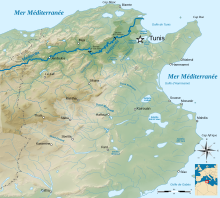| Battle of the Bagradas River | |||||||
|---|---|---|---|---|---|---|---|
| Part of Carthage's Mercenary War | |||||||
 Medjerda river drainage basin. | |||||||
| |||||||
| Belligerents | |||||||
| Carthage | Rebels | ||||||
| Commanders and leaders | |||||||
| Hamilcar Barca | Spendius | ||||||
| Strength | |||||||
|
8,000 infantry 2,000 cavalry 70 elephants | 20,000−25,000 men | ||||||
| Casualties and losses | |||||||
| Unknown |
6,000 killed 2,000 captured | ||||||
Location within Tunisia | |||||||
The Battle of the Bagradas River was fought between a Carthaginian army led by Hamilcar Barca and a rebel force led by Spendius in 240 BC in what is now north-east Tunisia. Carthage was fighting a coalition of mutinous soldiers and rebellious African cities in the Mercenary War, which had started late the previous year in the wake of the First Punic War. The rebels were blockading Carthage and besieging the northern ports of Utica and Hippo (modern Bizerte). A Carthaginian army commanded by Hanno had attempted and failed to relieve Utica early in 240 BC. A second army was assembled in Carthage and entrusted to Hamilcar, who had commanded Carthaginian forces on Sicily for the last six years of the First Punic War.
The new Carthaginian army left Carthage and evaded the rebel blockade by crossing the Bagradas River (the modern Medjerda River) at its mouth. Rebel armies commanded by Spendius from both the Utica siege and a camp guarding the only bridge over the lower Bagradas River marched towards the Carthaginians. When they came into sight Hamilcar ordered the Carthaginians to feign a retreat. The rebels broke ranks to chase after the Carthaginians and this impetuous pursuit caused them to fall into confusion. Once the rebels had drawn close, the Carthaginians turned and charged them. The rebels broke and were routed. The Carthaginians pursued, killing or capturing many of the rebels and taking the fortifications guarding the bridge.
This victory gave Hamilcar freedom to manoeuvre and the operational initiative. He confronted towns and cities that had gone over to the rebels, bringing them back to Carthaginian allegiance. Spendius confronted Hamilcar again in the mountains of north west Tunisia and Hamilcar was again victorious. Spendius had his Carthaginian prisoners tortured to death. Hamilcar in turn had existing and future prisoners trampled to death by elephants. After two further years of increasingly bitter warfare the rebels were worn down and eventually defeated at the Battle of Leptis Parva.

